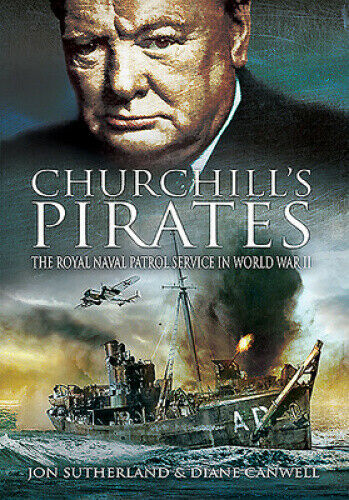
Churchill’s pirates: the Royal Naval Patrol Service in World War II. By Jon Sutherland and Diane Canwell. Barnsley, South Yorkshire: Pen and Sword Maritime, 2020.
Reviewed by John Johnston
This book, first published in 2010 and now reissued as a paperback, explores an often overlooked aspect of the Second World War at sea, the fleet of small craft – fishing boats, pleasure craft, tugs, and paddle steamers – that laid and cleared mines, escorted convoys, and conducted anti-submarine patrols around the British coasts and in all theatres from Arctic waters to the Indian Ocean.
Officially designated the Royal Naval Patrol Service, the motley fleet was commonly known as ‘Harry Tate’s Navy’ after the famous comedian and, less flatteringly, as ‘Churchill’s pirates’, both nicknames reflecting how uneasily the fishermen, yachtsmen, and ‘weekend sailors’ who formed the patrol service fitted into the hierarchies, structures, and culture of the Royal Navy proper. Being largely composed of men enlisted for ‘hostilities only’ and operating to its own rules and regulations, the patrol service might therefore appear merely one of the ‘private forces’ that operated in the British order of battle during the war and like so many of them, it might easily have passed into oblivion or become a curiosity of circumstances. Sutherland and Canwell deserve much credit for averting that happening and for demonstrating how the small vessels of the RNPS fitted into RN concepts of operations and the critical role they played in executing them.
Drawing on official records, contemporary accounts, and interviews with surviving veterans, Sutherland and Canwell trace the service from the origins of the RNPS from the anti-submarine campaign of the First World War to its establishment as one of the naval reserves and describe the operations and actions it performed during the Second World War and in the first years of peace. They show how the skills and knowledge of trawler men and drifter crews fitted them for the dangerous work of laying and clearing mines, and how the depth of experience and tough authority that the fishing fleet’s skippers had over their crews allowed them to operate with complete autonomy without disturbing the overall objective of an operation. Likewise, they bring out the respect which RN regulars and merchant mariners had for the seamanship and boat handling skills of the yacht masters and motor vessel skippers who escorted the convoys and cleared the sea lanes of enemy obstacles and shipping. Whilst irregular forces ashore may appear incidental to the main action, the little ships of the RPNS were integral to actions afloat.
Nevertheless, with only a single Oerlikon anti-aircraft gun, trawlers and the like were vulnerable to aerial, surface, and sub-surface attack, but the harsh realities of life among the fisherfolk made skippers and their crews indifferent to such dangers. Lieutenant Richard Standard, for instance, won the Victoria Cross at Narvik for repeatedly bringing his trawler, HMS Arab, into action against heavy enemy fire, but his report of the battle treats the pounding that his ship was taking as little different to that it would have suffered in an Atlantic gale. Other – less dramatic – examples of leadership and courage pepper the book and emphasise the unique character of the patrol service and its men in the face of the enemy and the high seas. Such bravery comes at a heavy cost and with over 500 vessels sunk – often with all hands – the patrol service lost more vessels than the rest of the Royal Navy during hostilities and continued to suffer casualties in postwar mine clearance operations.
Sutherland and Canwell give due prominence to the bravery and fortitude shown by the officers and men of the RNPS. The latter part of the book contains an index of vessels lost and the medal roll of honour that will gratify genealogists and researchers of family history, while students of military technology will find the operations of wooden hulled motor yachts and the armed trawlers have lessons for those of minesweepers and offshore patrol vessels today. The general reader, however, will be engrossed by this fascinating and compelling story of a strange and little known part of the war at sea.



